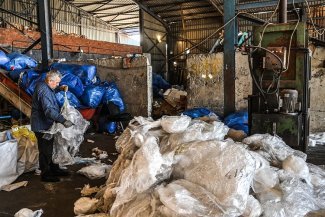The construction of a controversial oil pipeline through Native American tribal lands has been halted in the United States, casting doubt on its financial future. But with Donald Trump’s personal connections to the 1,172-mile-long Dakota Access Pipeline (DAPL) – and his strong ties to the oil and gas industry – the incoming US President could yet force the US$3.78 billion project through.
There was widespread jubilation when earlier this month, authorities announced that they would not grant permission for Dakota Access to drill under the Missouri River.
The pipeline, which would send roughly 470,000 barrels of crude a day from the Bakken oil fields in North Dakota to Illinois, is nearly complete – save for a small section of pipe north of the Standing Rock Sioux Tribe reservation.
The tribe had repeatedly expressed concern over the risk to water supplies from a leak or spill and desecration of sacred sites.
The official decision came just one day before a deadline for the removal of thousands of indigenous American and environmental activists at the Sacred Stone protest camp set up on the riverbanks in April this year.
Most recently hundreds of military veterans had arrived to support the protestors, who describe themselves “water protectors”.
More than 500 people were arrested during the months-long stand-off at Standing Rock, which became an international rallying point for indigenous and environmental rights.
Law enforcement officials were repeatedly accused of using excessive force, with unarmed protestors facing officers in riot gear with armoured vehicles, rubber bullets sound and water cannon, tear gas and “less-than-lethal” munitions.
During one night of clashes on 20 November, more than two dozen people were hospitalised and hundreds injured, including one 21-year-old woman whose arm was torn open and another who received eye injuries after reportedly being shot with a tear gas canister.
A crucial victory
On 4 December, the United States Army Corps of Engineers denied a permit for the construction of a key section of the DAPL, granting a crucial victory to protesters – one that both water protectors and the corporations behind the DAPL project credit to White House involvement.
Standing Rock Sioux Tribal Chairman Dave Archambault II said his people and other tribes would be “forever grateful to the Obama Administration for this historic decision”.
A statement from the parent company behind the project, Energy Transfer Partners, called the decision “a purely political action”, noting:
“As stated all along, [Energy Transfer Partners and Sunoco] are fully committed to ensuring that this vital project is brought to completion and fully expect to complete construction of the pipeline without any additional re-routing in and around Lake Oahe. Nothing this Administration has done today changes that in any way.”
Those at the Sacred Stone camp marked their victory over the “black snake” with fireworks and celebrations. But water protectors were under no illusions that after his inauguration on 20 January 2017, Donald Trump may start undoing much of their hard work by forcing the pipeline project to completion.
In a memo to supporters earlier this month Trump spokesperson Bryan Lanza confirmed the President-elect wanted the project finished in a decision that had “nothing to do with his personal investments and everything to do with promoting policies that benefit all Americans.”
As of May 2015, Trump’s personal investment in the project amounted to between US$500,000 and US$1 million worth of shares in Energy Transfer Partners. This then fell to less than US$50,000 by the summer of 2016. Another Trump spokesperson told the Washington Post that the president-elect has sold all of his shares in the company, although his transition team has failed to provide any proof.
The most recent disclosure also revealed at least US$100,000 shares in Phillips 66, an energy company that owns one-quarter of the pipeline.
Money flows
Money has flowed the other way too. Kelcy Warren, chief executive of Energy Transfer Partners, gave US$103,000 to elect Trump and handed over a further US$66,800 to the Republican National Committee after the reality TV host secured its presidential nomination, The Guardian reported.
Warren also reportedly contributed US$5 million to the political action committee that supported former Texan Governor and Dancing with the Stars contestant Rick Perry’s presidential campaign. Perry sits on the board of Energy Transfer Partners, owns US$100,000 worth of the company’s stock and is now Trump’s top pick for Energy Secretary.
Before the Standing Rock victory, Warren told NBC News:
"I’m 100 percent sure that the pipeline will be approved by a Trump administration. I believe we will have a government in place that believes in energy infrastructure."
The oil industry’s links to Trump’s future administration should be further concern for campaigners.
Trump’s energy policy adviser is oil billionaire Harold Hamm, CEO of the largest fracking company in the US, Continental Resources. Hamm has made billions of dollars drilling and fracking in North Dakota and it would be Continental’s oil that flows through a completed DAPL, it has been reported.
And Trump has since appointed Rex Tillerson, the former chief executive of oil giant ExxonMobil as his choice for Secretary of State.
Tillerson has only ever worked for Exxon and while he may have more than US$230 million in company shares and close ties to Vladimir Putin, he has no experience in public office.
Spill fears coming true
But the biggest concern for the Standing Rock community is the prospect of oil spills contaminating their water supply.
These fears played out recently when more than 176,000 gallons of crude oil leaked from another company’s pipeline, the Belle Fourche, into the Ash Coulee Creek – just 150 miles away from the Dakota Access protest camps.
While Dakota Access says their pipeline will be safe, as the remote workers who monitor it will able to shut down the pipeline if a leak is detected, such electronic monitoring failed to detect the Belle Fourche rupture, which was eventually spotted by a local landowner on 5 December. Clean-up efforts were also hampered by falling temperatures.
Major pipeline spills are not easy to fix. Clean-up efforts are continuing at the site of another North Dakota pipeline rupture more than three years later.
And last week it was revealed that less than a third of the 840,000 gallons that contaminated nearby wheatfields when a Tesoro Corp pipeline burst in 2013 has been recovered, or ever will be, the North Dakota Health Department said.
But for LaDonna Brave Bull Allard, founder of the Standing Rock Sioux resistance camp, the area that Dakota Access wants to drill beneath does not just provide water but a vital link to her ancestors. “We must remember we are part of a larger story," she said. "My father is buried at the top of the hill, overlooking our camp on the riverbank below. My son is buried there, too.
“Two years ago, when Dakota Access first came, I looked at the pipeline map and knew that my entire world was in danger. If we allow this pipeline, we will lose everything.
“We are the river, and the river is us. We have no choice but to stand up.”









